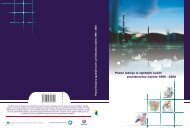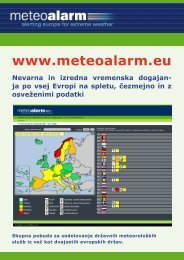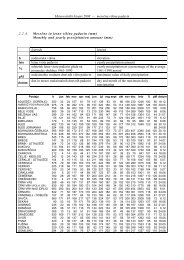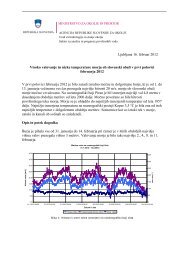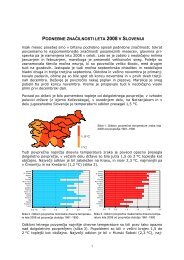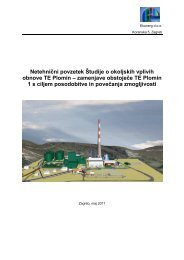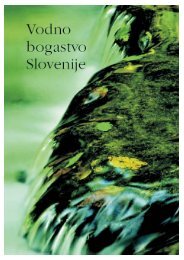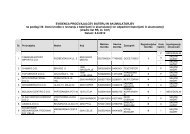Water Quality in Slovenia - Agencija RS za okolje
Water Quality in Slovenia - Agencija RS za okolje
Water Quality in Slovenia - Agencija RS za okolje
You also want an ePaper? Increase the reach of your titles
YUMPU automatically turns print PDFs into web optimized ePapers that Google loves.
58<br />
W A T E R Q U A L I T Y I N S L O V E N I A<br />
Divje jezero Krupa spr<strong>in</strong>g<br />
Based on statistically treated results, the chemical status of a groundwater body is assessed every<br />
year. For each parameter, annual arithmetic mean values (AM) are calculated at <strong>in</strong>dividual monitor<strong>in</strong>g<br />
sites. From the annual arithmetic mean values of <strong>in</strong>dividual monitor<strong>in</strong>g sites, the representative<br />
average value for a groundwater body is calculated (AM ), where each monitor<strong>in</strong>g site is weighted<br />
SK<br />
proportionally to the catchment area.<br />
A good groundwater body chemical status is assessed if the follow<strong>in</strong>g requirements are fulfilled:<br />
• for all parameters at all monitor<strong>in</strong>g sites with<strong>in</strong> the groundwater body borders, the follow<strong>in</strong>g<br />
applies: AM ≤ QS (quality standard)<br />
or<br />
• for all parameters for a groundwater body, the follow<strong>in</strong>g applies: AM ≤ QS,<br />
SK<br />
• dr<strong>in</strong>k<strong>in</strong>g water pumped from the groundwater body is compliant with the requirements set out <strong>in</strong><br />
the Rules on Dr<strong>in</strong>k<strong>in</strong>g <strong>Water</strong>,<br />
• there is no <strong>in</strong>dication of salt water <strong>in</strong>trusion <strong>in</strong>to the groundwater body,<br />
• groundwater pollution does not deteriorate the status of surface waters and does not have<br />
damag<strong>in</strong>g effects on neither terrestrial nor aquatic ecosystems.<br />
Out of 15 groundwater bodies where national monitor<strong>in</strong>g network and monitor<strong>in</strong>g sites are<br />
situated, chemical statuses of 9 groundwater bodies were determ<strong>in</strong>ed <strong>in</strong> 2006. In four groundwater<br />
bodies, the chemical status was only estimated, while for two groundwater bodies the network was<br />
not representative enough for evaluation. The chemical status of groundwater bodies <strong>in</strong> 2006 is<br />
presented <strong>in</strong> Map 12 and <strong>in</strong> Table 17, together with an <strong>in</strong>dication of the parameters caus<strong>in</strong>g a bad<br />
chemical status, and the polluted parts of a groundwater body. A bad chemical status assessed on<br />
the results for groundwater as well as on the monitor<strong>in</strong>g results of dr<strong>in</strong>k<strong>in</strong>g water was determ<strong>in</strong>ed<br />
for three groundwater bodies: the Dravska kotl<strong>in</strong>a, the Murska kotl<strong>in</strong>a and the Krška kotl<strong>in</strong>a. In the<br />
Drava and the Krška kotl<strong>in</strong>a, a bad chemical status was assessed due to nitrates and pesticides that<br />
are characteristic of agricultural activity, while <strong>in</strong> the Murska kotl<strong>in</strong>a, additionally due to chlor<strong>in</strong>ated<br />
derivatives of ethene that are still used <strong>in</strong> <strong>in</strong>dustrial and trade activities. In 2006, a bad chemical status<br />
of the Krška kotl<strong>in</strong>a was determ<strong>in</strong>ed for the first time.




